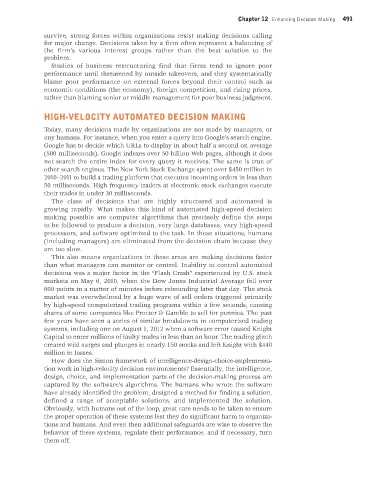Page 492 -
P. 492
Chapter 12 Enhancing Decision Making 491
survive, strong forces within organizations resist making decisions calling
for major change. Decisions taken by a firm often represent a balancing of
the firm’s various interest groups rather than the best solution to the
problem.
Studies of business restructuring find that firms tend to ignore poor
performance until threatened by outside takeovers, and they systematically
blame poor performance on external forces beyond their control such as
economic conditions (the economy), foreign competition, and rising prices,
rather than blaming senior or middle management for poor business judgment.
HIGH-VELOCITY AUTOMATED DECISION MAKING
Today, many decisions made by organizations are not made by managers, or
any humans. For instance, when you enter a query into Google’s search engine,
Google has to decide which URLs to display in about half a second on average
(500 milliseconds). Google indexes over 50 billion Web pages, although it does
not search the entire index for every query it receives. The same is true of
other search engines. The New York Stock Exchange spent over $450 million in
2010–2011 to build a trading platform that executes incoming orders in less than
50 milliseconds. High frequency traders at electronic stock exchanges execute
their trades in under 30 milliseconds.
The class of decisions that are highly structured and automated is
growing rapidly. What makes this kind of automated high-speed decision
making possible are computer algorithms that precisely define the steps
to be followed to produce a decision, very large databases, very high-speed
processors, and software optimized to the task. In these situations, humans
(including managers) are eliminated from the decision chain because they
are too slow.
This also means organizations in these areas are making decisions faster
than what managers can monitor or control. Inability to control automated
decisions was a major factor in the “Flash Crash” experienced by U.S. stock
markets on May 6, 2010, when the Dow Jones Industrial Average fell over
600 points in a matter of minutes before rebounding later that day. The stock
market was overwhelmed by a huge wave of sell orders triggered primarily
by high-speed computerized trading programs within a few seconds, causing
shares of some companies like Procter & Gamble to sell for pennies. The past
few years have seen a series of similar breakdowns in computerized trading
systems, including one on August 1, 2012 when a software error caused Knight
Capital to enter millions of faulty trades in less than an hour. The trading glitch
created wild surges and plunges in nearly 150 stocks and left Knight with $440
million in losses.
How does the Simon framework of intelligence-design-choice-implementa-
tion work in high-velocity decision environments? Essentially, the intelligence,
design, choice, and implementation parts of the decision-making process are
captured by the software’s algorithms. The humans who wrote the software
have already identified the problem, designed a method for finding a solution,
defined a range of acceptable solutions, and implemented the solution.
Obviously, with humans out of the loop, great care needs to be taken to ensure
the proper operation of these systems lest they do significant harm to organiza-
tions and humans. And even then additional safeguards are wise to observe the
behavior of these systems, regulate their performance, and if necessary, turn
them off.
MIS_13_Ch_12 global.indd 491 1/17/2013 2:30:30 PM

